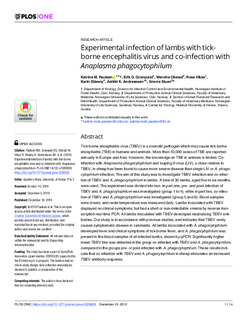| dc.contributor.author | Paulsen, Katrine Mørk | |
| dc.contributor.author | Granquist, Erik Georg | |
| dc.contributor.author | Okstad, Wenche | |
| dc.contributor.author | Andreassen, Åshild Kristine | |
| dc.contributor.author | Stuen, Snorre | |
| dc.contributor.author | Vikse, Rose | |
| dc.contributor.author | Stiasny, Karin | |
| dc.date.accessioned | 2020-01-16T10:04:08Z | |
| dc.date.available | 2020-01-16T10:04:08Z | |
| dc.date.created | 2020-01-13T14:43:44Z | |
| dc.date.issued | 2019 | |
| dc.identifier.citation | PLOS ONE. 2019, 14(12). | nb_NO |
| dc.identifier.issn | 1932-6203 | |
| dc.identifier.uri | http://hdl.handle.net/11250/2636599 | |
| dc.description | This is an open access article distributed under the terms of the Creative Commons Attribution License, which permits unrestricted use, distribution, and reproduction in any medium, provided the original author and source are credited. | nb_NO |
| dc.description.abstract | Tick-borne encephalitis virus (TBEV) is a zoonotic pathogen which may cause tick-borne encephalitis (TBE) in humans and animals. More than 10,000 cases of TBE are reported annually in Europe and Asia. However, the knowledge on TBE in animals is limited. Co-infection with Anaplasma phagocytophilum and louping ill virus (LIV), a close relative to TBEV, in sheep has been found to cause more severe disease than single LIV or A. phagocytophilum infection. The aim of this study was to investigate TBEV infection and co-infection of TBEV and A. phagocytophilum in lambs. A total of 30 lambs, aged five to six months, were used. The experiment was divided into two. In part one, pre- and post-infection of TBEV and A. phagocytophilum was investigated (group 1 to 4), while in part two, co-infection of TBEV and A. phagocytophilum was investigated (group 5 and 6). Blood samples were drawn, and rectal temperature was measured daily. Lambs inoculated with TBEV displayed no clinical symptoms, but had a short or non-detectable viremia by reverse transcription real-time PCR. All lambs inoculated with TBEV developed neutralizing TBEV antibodies. Our study is in accordance with previous studies, and indicates that TBEV rarely causes symptomatic disease in ruminants. All lambs inoculated with A. phagocytophilum developed fever and clinical symptoms of tick-borne fever, and A. phagocytophilum was present in the blood samples of all infected lambs, shown by qPCR. Significantly higher mean TBEV titer was detected in the group co-infected with TBEV and A. phagocytophilum, compared to the groups pre- or post-infected with A. phagocytophilum. These results indicate that co-infection with TBEV and A. phagocytophilum in sheep stimulates an increased TBEV antibody response. | nb_NO |
| dc.description.sponsorship | The study has been a part of ScandTick Innovation (grant number 20200422) supported by the EU Interreg V-A program. The funders had no role in study design, data collection and analysis, decision to publish, or preparation of the manuscript. | nb_NO |
| dc.language.iso | eng | nb_NO |
| dc.rights | Navngivelse 4.0 Internasjonal | * |
| dc.rights.uri | http://creativecommons.org/licenses/by/4.0/deed.no | * |
| dc.title | Experimental infection of lambs with tick-borne encephalitis virus and co-infection with Anaplasma phagocytophilum. | nb_NO |
| dc.type | Journal article | nb_NO |
| dc.type | Peer reviewed | nb_NO |
| dc.description.version | publishedVersion | nb_NO |
| dc.rights.holder | © 2019 Paulsen et al | nb_NO |
| dc.source.pagenumber | 9 | nb_NO |
| dc.source.volume | 14 | nb_NO |
| dc.source.journal | PLOS ONE | nb_NO |
| dc.source.issue | 12 | nb_NO |
| dc.identifier.doi | 10.1371/journal.pone.0226836 | |
| dc.identifier.cristin | 1771609 | |
| cristin.unitcode | 222,58,1,0 | |
| cristin.unitname | Institutt for natur, helse og miljø | |
| cristin.ispublished | true | |
| cristin.fulltext | original | |
| cristin.qualitycode | 1 | |

